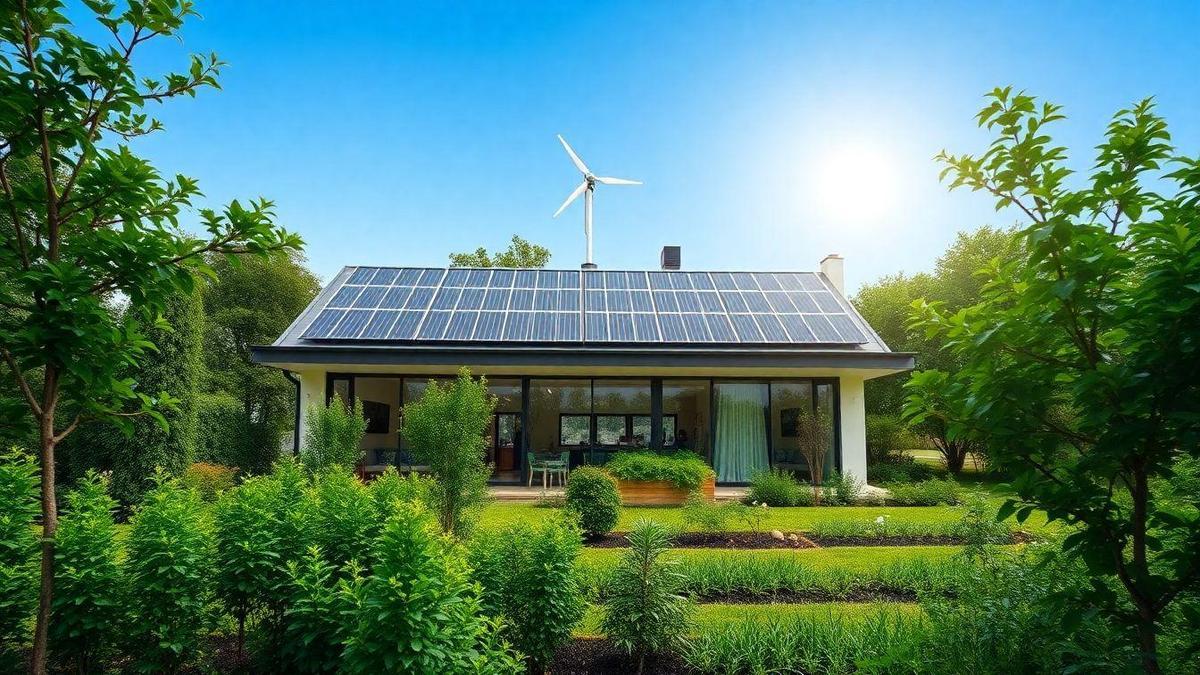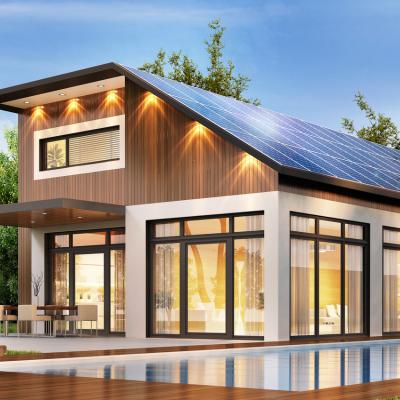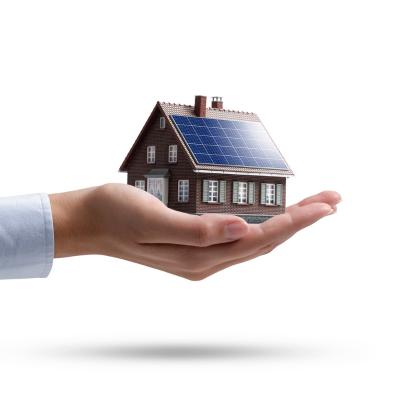Anúncios
Energy self-sufficient homes represent a viable and sustainable alternative to traditional buildings. By using renewable sources and smart solutions, they can generate their own energy. This energy autonomy contributes to a greener and more conscious future.
Anúncios
The design of these homes focuses on efficiency and the rational use of available natural resources. The integration of modern technologies and sustainable practices allows for comfort without waste. This transforms the way we live and relate to the environment.

Renewable Energy as the Pillar of Self-Sufficiency
Renewable energy sources are at the heart of self-sufficient homes. Solar panels capture sunlight and convert it into electricity for daily use. Wind turbines can also be integrated, depending on local conditions.
These systems allow the home to operate independently from the traditional power grid. In regions with high solar incidence, it is possible to generate more energy than is consumed. This results in savings and even energy credits in some countries.
The choice of the most suitable renewable source depends on climate and location. Sunny locations favor solar panels, while areas with constant winds benefit from turbines. The smart combination of these sources enhances the system’s efficiency.
Besides generation, energy storage is essential. Batteries ensure constant supply even at night or on cloudy days. This energy autonomy ensures comfort and stability in any situation.
Passive Design and Energy Efficiency
Passive design maximizes the use of natural resources. It considers factors such as solar orientation, cross-ventilation, and the use of thermal materials. This reduces the need for artificial heating or cooling.
Well-designed homes maintain a stable internal temperature throughout the year. This is due to efficient insulation and the use of high thermal inertia materials. Eaves and well-placed windows also help control light and heat.
Natural ventilation is another key element. It improves indoor air quality and reduces dependence on mechanical systems. Strategically placed windows create airflow that naturally cools the rooms.
Natural lighting is also valued in these designs. Well-lit spaces consume less electricity during the day. Thus, passive design combines thermal and light comfort with energy efficiency.
How Energy Self-Sufficient Homes Work

Energy self-sufficient homes are designed to produce as much energy as they consume, creating a balance that allows them to operate independently of traditional energy grids. This innovative approach uses a combination of renewable energy sources, energy-efficient technologies, and sustainable materials to minimize environmental impact and reduce reliance on fossil fuels. By harnessing the power of the sun, wind, and other renewable resources, these homes can generate their own electricity, heating, and hot water, resulting in significant savings and a reduced carbon footprint.
At the core of energy self-sufficient homes is the integration of various systems that work in harmony to achieve energy independence. Solar panels are often installed on roofs to capture sunlight and convert it into electricity, while solar thermal systems can provide heating for water and living spaces. Wind turbines can also be incorporated, depending on location and wind resource availability. Additionally, energy storage solutions such as batteries allow homeowners to store excess energy generated during high production periods for use during times of low generation. This combination of technologies ensures that energy self-sufficient homes can maintain a consistent energy supply year-round.
Another critical aspect of energy self-sufficient homes is the focus on energy efficiency. This is achieved through the use of high-quality insulation, energy-efficient windows, and advanced heating and cooling systems that minimize energy losses. By reducing the home’s overall energy demand, homeowners can rely more on their renewable energy systems and less on external sources. Moreover, smart home technologies can optimize energy usage by monitoring consumption patterns and adjusting settings as needed, ensuring energy is used efficiently and effectively.
Sustainable design principles also play a significant role in the functionality of energy self-sufficient homes. These principles prioritize the use of environmentally friendly materials, water conservation, and waste reduction, all contributing to the overall sustainability of the home. By designing spaces that are adaptable and resilient, energy self-sufficient homes can thrive in various climates and conditions, providing comfort and functionality for occupants while minimizing their ecological impact.
Advantages of Energy Self-Sufficient Homes Through Sustainable Design
The advantages of energy self-sufficient homes are numerous and far-reaching, impacting not only homeowners but also the environment and society as a whole. One of the most significant benefits is the reduction in energy costs. By generating their own electricity and heat, homeowners can significantly lower their monthly utility bills, resulting in substantial long-term savings. In addition, many governments and local authorities offer incentives and tax breaks for homeowners who invest in renewable energy technologies, further enhancing the financial benefits of energy self-sufficient homes.
Another advantage is the positive impact on the environment. Energy self-sufficient homes contribute to reducing greenhouse gas emissions by relying on renewable energy sources instead of fossil fuels. This shift helps combat climate change and promotes a healthier planet for future generations. Additionally, sustainable design practices often involve using locally sourced materials and minimizing waste, which supports a more circular economy and reduces the overall environmental footprint of the construction process.
Energy self-sufficient homes also provide greater energy security and independence. By producing their own energy, homeowners are less vulnerable to energy price fluctuations and supply interruptions caused by natural disasters or geopolitical tensions. This independence can lead to greater resilience in the face of changes in the energy landscape and a more stable living environment for families. Furthermore, as more people adopt energy self-sufficient practices, the demand for traditional energy sources decreases, contributing to a more sustainable energy future.
Finally, energy self-sufficient homes often promote a healthier living environment. Many sustainable design principles emphasize natural ventilation, natural lighting, and the use of non-toxic materials, resulting in better indoor air quality and overall well-being for occupants. By creating spaces that are not only energy-efficient but also conducive to health and comfort, energy self-sufficient homes can enhance the quality of life for their residents, fostering a deeper connection with nature and the surrounding environment.
How to Create Energy Self-Sufficient Homes Through Sustainable Design

Creating energy self-sufficient homes through sustainable design involves a multifaceted approach that integrates various technologies and practices. Here are some key strategies to consider:
Use Renewable Energy Sources: Incorporating solar panels, wind turbines, and other renewable energy systems is essential for generating clean energy. Homeowners should assess their location and energy needs to determine the most suitable renewable energy sources for their homes.
Implement Energy Efficiency Measures: Improving a home’s energy efficiency is crucial to reduce energy demand. This can be achieved through high-quality insulation, energy-efficient windows, and advanced heating and cooling systems that minimize energy losses.
Choose Sustainable Building Materials: Selecting sustainable materials for construction is vital to reduce environmental impact. This includes using locally sourced, recycled, or reclaimed materials that are non-toxic and have a low carbon footprint.
Incorporate Passive Solar Design: Designing homes to take advantage of sunlight and natural ventilation can significantly reduce energy consumption. This includes strategically placing windows, eaves, and thermal mass materials to optimize natural heating and cooling.
Plan for Off-Grid Living: Homeowners should consider designing their homes to operate independently from the power grid. This involves incorporating energy storage solutions, such as batteries, and ensuring the home can function effectively without relying on external energy sources.
Design for Net-Zero Energy Buildings: Aiming for a net-zero energy building means that the home produces as much energy as it consumes over the year. This requires a comprehensive approach that combines renewable energy generation, energy efficiency, and smart technologies.
By implementing these strategies, homeowners can create energy self-sufficient homes that not only reduce their environmental impact but also provide financial savings and a healthier living environment. The journey toward energy independence begins with careful planning and a commitment to sustainable design practices.
Did You Enjoy Learning About Energy Self-Sufficient Homes Through Sustainable Design?
Energy self-sufficient homes represent a remarkable shift in how we approach residential living, combining innovative technologies with sustainable design principles to create spaces that are both functional and environmentally friendly. The benefits of adopting such practices extend beyond individual homeowners, contributing to a more sustainable future for our planet. As we continue to explore and implement these ideas, we can pave the way for a greener, healthier world.
If you’re intrigued by the concept of energy self-sufficient homes and the possibilities they offer, there’s much more to discover. From the latest advancements in renewable energy technologies to innovative design practices, the journey toward energy independence is full of exciting opportunities for homeowners and communities alike. Embrace the challenge and join the movement toward a sustainable future!
Frequently Asked Questions
What are energy self-sufficient homes through sustainable design?
Energy self-sufficient homes use less energy than they produce. They use sustainable design to generate energy.
How can I make my home energy self-sufficient?
You can install solar panels, use wind turbines, and improve insulation. These are great ways to start.
What are the benefits of sustainably designed homes?
They save energy and lower bills. They also help the environment and increase comfort.
Is it expensive to build a self-sufficient home?
Initial costs can be high, but you save in the long run. Lower energy bills make a difference.
Where can I learn more about sustainable design?
There are many websites, books, and videos. Explore local communities and social networks. You’ll find plenty of useful tips!
